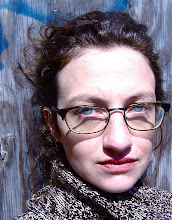Amory Show Aftermath
At the Armory show last weekend, one artist from Pierogi Gallery had presented a drawing I had thought of as bloggy. Having not written down the guy's name and having been made aware by the Amory that I've let my general art-competency fade, I went out to Williamsberg the other day. At Pierogi, the staff was in the middle of mounting a show of the guy in question's work. Felicitous!
His name is Jim Torok, and he makes narrative drawings, by which I mean that small naif sketches are arranged in horizontal story boards (no frames) with lots of accompanying text drawn into the scenes.
The subject of the texts and images are largely autobiographical; the perspective portrayed is that of the artist himself. Some of the stories narrate events in Torok's life, like "Trip to New York," or "Sometimes I Think Bad Things." Some of the works tinker with McSweeney-like ironic meta-artistic zaniness, like "This Is A Major Work," in which a primitive talking-head artist-stand-in tries to convince the viewer that, indeed, it is a major work.
Cute--and a bit thin.
The work shown at the Armory, "Fuck-You Assholes," was still interesting to me: the images were more closely pressed together, the composition busier and less relentlessly horizontal, and more important to me, the voice of the text hovering between the personal and the demotic. The voice is both a cri de coeur and an encapsulation of what everyone around here (New York and the liberal blogosphere) is saying.
The other works are less compelling because the voice and stories seem to be so familiar from literary movements, where the star of such a style is already waning. The poet James Tate is exemplary in the limpid little ironic reversal narrative style. And even Dave Eggers's "velocity" has spun off into more sincere, adult projects, like the generally excellent Believer review. (And yes, I think it entirely fair to criticize the literary merits of a visual artwork that uses textual narrative.) I also think the composition of many of the pieces shown at Pierogi repetitive--and somewhat contrived in their abstraction of comic framing.
Images from Pierogi's flatfiles.
His name is Jim Torok, and he makes narrative drawings, by which I mean that small naif sketches are arranged in horizontal story boards (no frames) with lots of accompanying text drawn into the scenes.
The subject of the texts and images are largely autobiographical; the perspective portrayed is that of the artist himself. Some of the stories narrate events in Torok's life, like "Trip to New York," or "Sometimes I Think Bad Things." Some of the works tinker with McSweeney-like ironic meta-artistic zaniness, like "This Is A Major Work," in which a primitive talking-head artist-stand-in tries to convince the viewer that, indeed, it is a major work.
Cute--and a bit thin.
The work shown at the Armory, "Fuck-You Assholes," was still interesting to me: the images were more closely pressed together, the composition busier and less relentlessly horizontal, and more important to me, the voice of the text hovering between the personal and the demotic. The voice is both a cri de coeur and an encapsulation of what everyone around here (New York and the liberal blogosphere) is saying.
The other works are less compelling because the voice and stories seem to be so familiar from literary movements, where the star of such a style is already waning. The poet James Tate is exemplary in the limpid little ironic reversal narrative style. And even Dave Eggers's "velocity" has spun off into more sincere, adult projects, like the generally excellent Believer review. (And yes, I think it entirely fair to criticize the literary merits of a visual artwork that uses textual narrative.) I also think the composition of many of the pieces shown at Pierogi repetitive--and somewhat contrived in their abstraction of comic framing.
Images from Pierogi's flatfiles.



0 Comments:
Post a Comment
<< Home